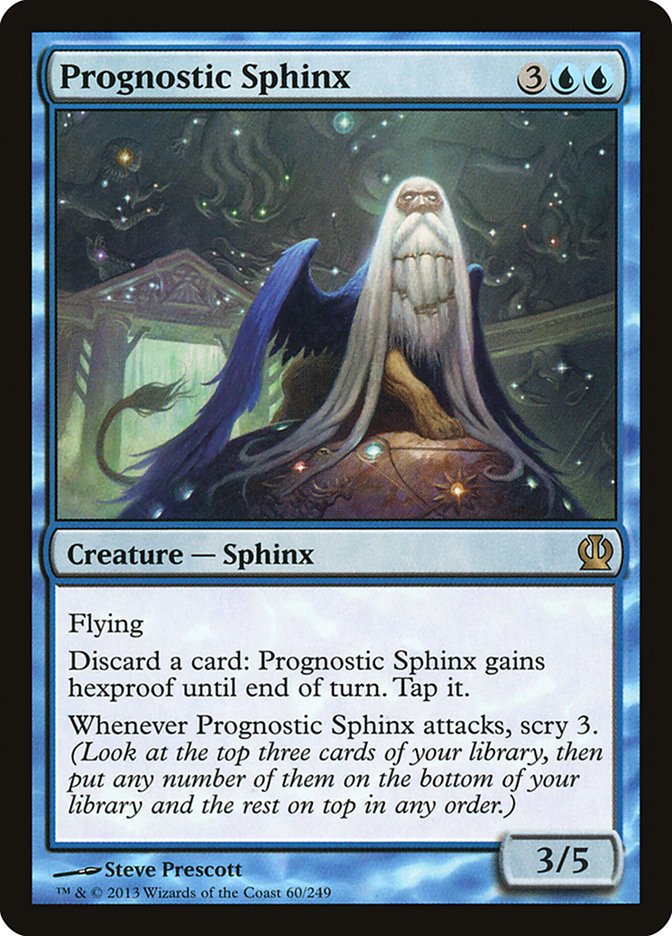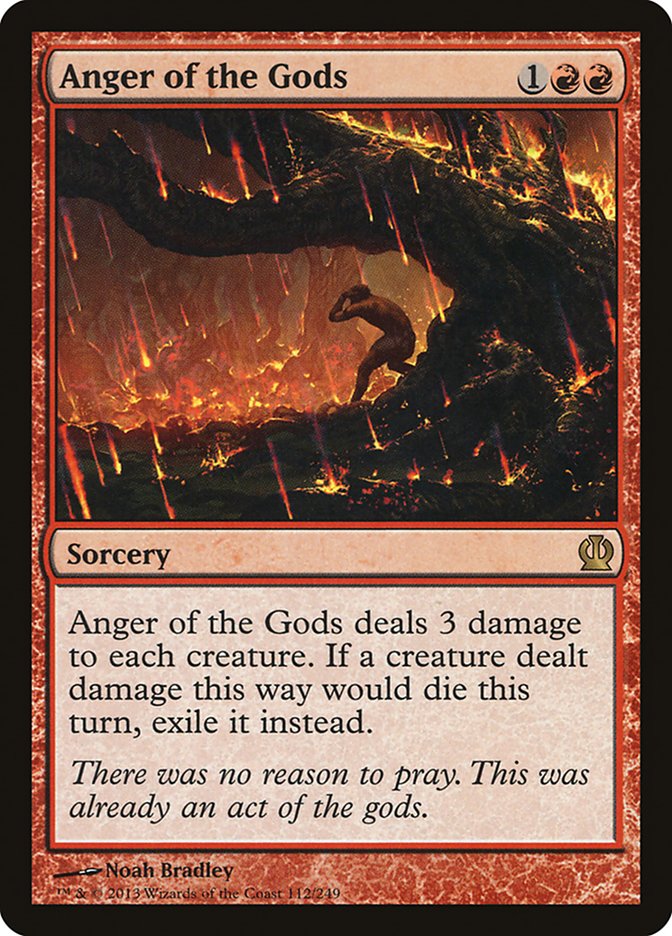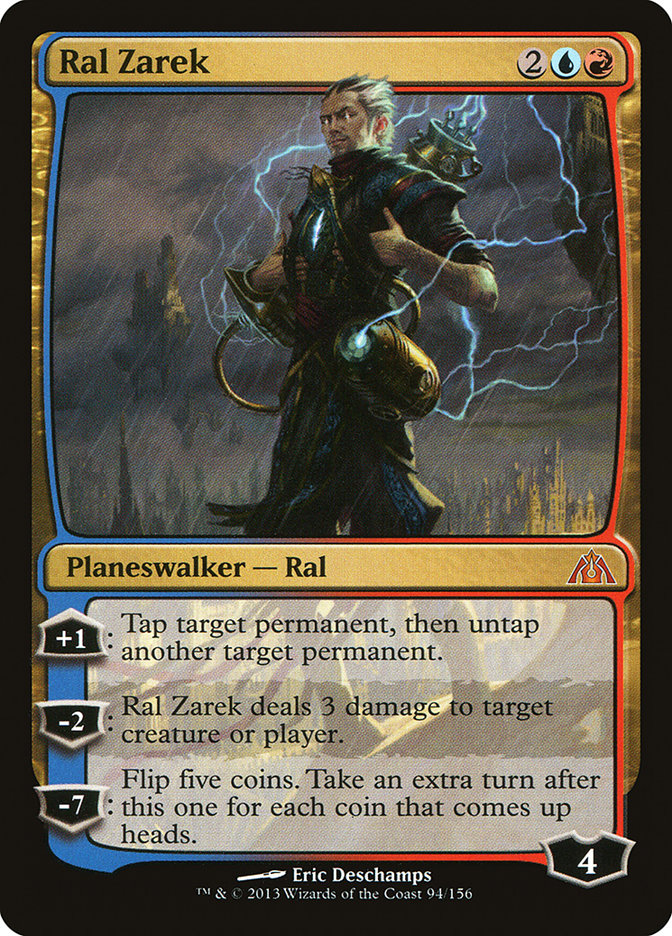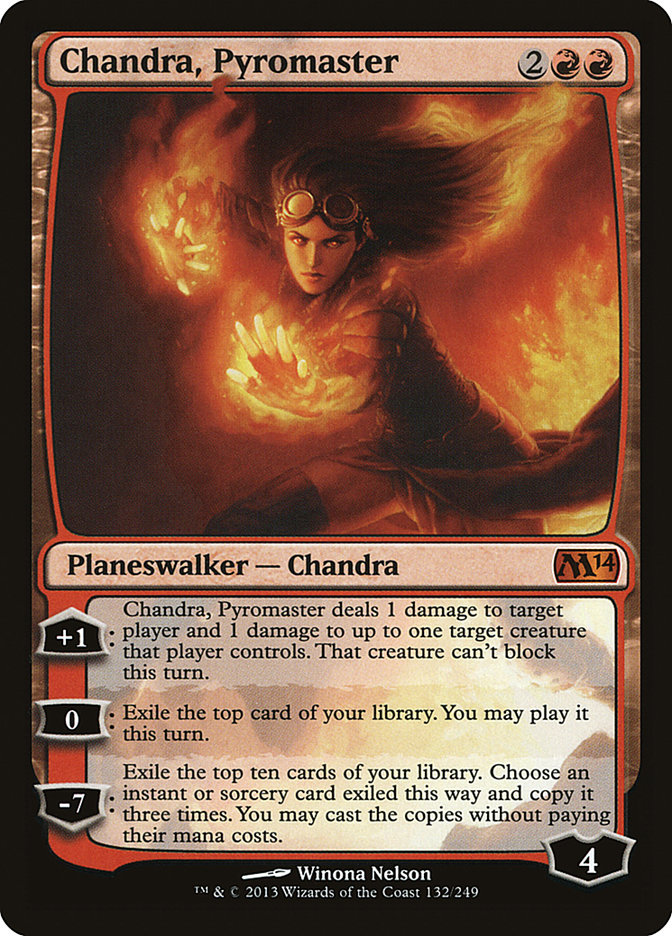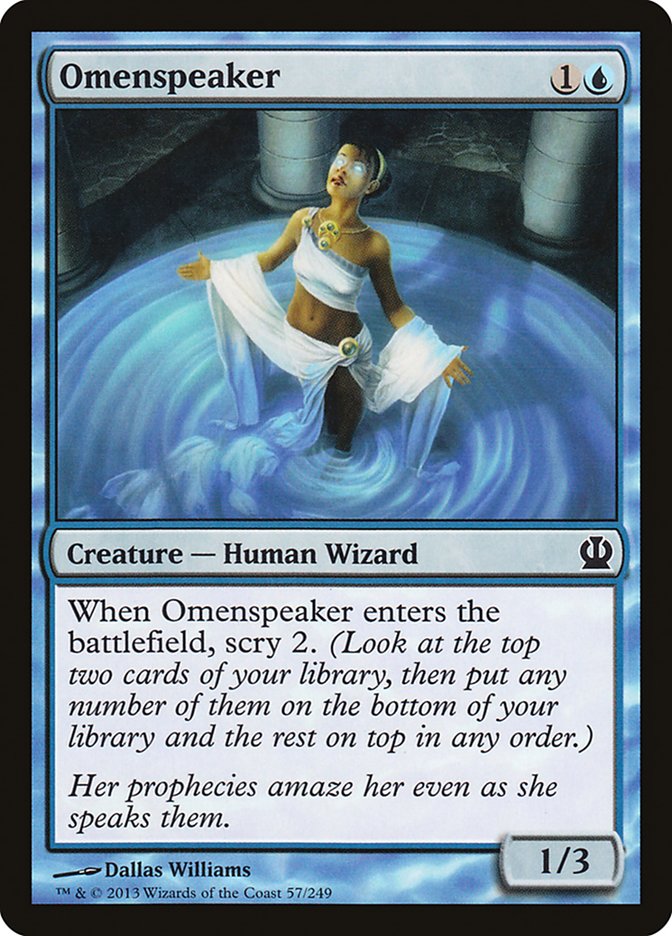Warning: This is a control-centric one . . .
Now that Theros has been completely spoiled, we can dive headfirst into brewing for the new Standard. There are so many new cards to try, and so many of them require new strategies to fully utilize that it’s going to take a bit of exploration to figure out where we want to be. We do have to start somewhere, however, and what better place to start than with control?
There are a pretty good chunk of cards worth considering for control decks, but first we would do well to figure out what the format is even going to look like. The starting point for fall Standard formats is generally at least largely based on the previous Block Constructed format (as three out of five of its sets were just that). That points to U/W/x Control, along with G/W Aggro, Red Aggro, R/B/W, Maze’s End, and B/G/x Aggro.
Looking at the other two sets, what are some loud ways in which they influence the Block format? This isn’t always a question of what’s new, but rather what’s new to block?
Major M14 cards:
- 5x Planeswalkers (including Jace, Chandra, and Garruk)
- 5x Color-Hoser Creatures
- Slivers
- Archangel of Thune
- Banisher Priest
- Brave the Elements
- Celestial Flare
- Imposing Sovereign
- Planar Cleansing
- Divination
- Essence Scatter
- Negate
- Opportunity
- Doom Blade
- Duress
- Shadowborn Demon
- Wring Flesh
- Xathrid Necromancer
- Burning Earth
- Chandra’s Phoenix
- Burn Spells (Shock, Lightning Strike, Flames of the Firebrand)
- Molten Birth
- Ogre Battledriver
- Scourge of Valkas
- Young Pyromancer
- Elvish Mystic
- Gladecover Scout
- Kalonian Hydra
- Kalonian Tusker
- Lay of the Land
- Primeval Bounty
- Scavenging Ooze
- Elixir of Immortality
- Ratchet Bomb
- Mutavault
- Encroaching Wastes
There is no shortage of impactful cards in M14 that are going to alter a lot of what we knew about Block, and this doesn’t even come close to hitting all of the fringe role players. As for Theros, we have a lot to figure out, but a few trends are pretty clear.
1. A lot more enchantments will be played. Many will also be creatures and/or legendary and/or artifacts and/or indestructible.
2. Red Aggro gets a lot of really strong new tools. Combine the best of the Gods, tons of cheap burn (which Block was missing), and Burning Earth and Mono-Red Aggro looks to be the deck to beat on the first day.
3. There are a lot of new two-power one-drops. We just lost a bunch from Innistrad block, but those weren’t in Return to Ravnica block anyway. The whole slew of two-power one-drops adds a lot more fast and hard-hitting aggression than the Block format ever had.
4. Mana is only marginally better than what was available in Block but now has to deal with Burning Earth existing, which strongly pushes us towards two-color (or monocolor) decks.
Finally . . .
Top 10 Return to Ravnica Block Cards
10. Mizzium Mortars
9. Loxodon Smiter
8. Jace, Architect of Thought
7. Aetherling
6. Boros Reckoner
5. Burning-Tree Emissary
4. Supreme Verdict
3. Domri Rade
2. Sphinx’s Revelation
1. Voice of Resurgence
Looking at these observations, we then want to extrapolate more about the format, looking for clues for what direction to start with. For instance, one of the loudest differences between Block and new Standard is the existence of Burning Earth. The Theros duals coming into play tapped despite how much faster and aggressive the format looks suggests we probably want to start with two colors as the default and make sure a third color is worth what it costs. Five of the color combinations don’t even get a scry land!
While monocolor aggro is very promising, we can quickly rule out monocolor control, or at least mono-blue control. Two-power one-drops look devastating, and many of the best cards all destroy mono-blue, such as Voice of Resurgence, Domri Rade, and Loxodon Smiter, to say nothing of new "special" color hoser Mistcutter Hydra.
Mono-Black Control might have a chance if it can get over the lack of a good sweeper and find a good way to capitalize on Whip of Erebos. Staying mono-white doesn’t really offer us anything close to as good as the Azorius cards. Mono-Red Control isn’t really "control," but there’s no real reason to avoid aggression even if we decide to play a little slower or bigger of a red deck. Mono-green doesn’t really have any incentives to play a controlling strategy.
To play a real "control" deck, we are probably looking at U/x. If we are serious about staying two colors, what options does that leave us?
The most obvious, of course, is U/W since the Azorius guild was significantly stronger than the other blue guilds in Return to Ravnica block.
Creatures (2)
Planeswalkers (4)
Lands (27)
Spells (27)

In Block Constructed, U/W needed to be paired with black or green due to a shortage of cheap interaction. M14 and Theros help a bit in this area.
To start with, Last Breath looks like it might actually be particularly well-positioned. There look to be a ton of two-power creatures, so we are rarely going to be want for a target. Nobody wants it to come to this, but in a pinch you can also Last Breath your Mutavault to gain four life against direct damage. What makes the card really exciting, though, is that removes Voice of Resurgence without giving them a token. This is especially important due to our reliance on spells that are generally played on the opponent’s turn, such as Azorius Charm, Celestial Flare, Syncopate, and Dissolve.
Ratchet Bomb is another great cheap, interactive card that really helps keep people from overrunning you with one-drops. That it also gives us more answers to walkers, enchantments, and tokens is just gravy.
Celestial Flare isn’t the most efficient card in the format, but we need cheap removal and it’s one of the best answers to Stormbreath Dragon since it gets around protection from white.
Dissolve is generally better than Dissipate, which just rotated, and clearly better than Cancel. In general, I would rather have a Dissolve than a Render Silent. Counterflux is where things get interesting. Psychic Strike is weaker but has a novel casting cost.
Aetherling is the default kill card of choice, but it is more important than it used to be to have multiple roads to victory. It’s not just stuff like Slaughter Games and Counterflux. Sometimes, opponents are going to be able to Fog Aetherling a few times or just win the race, and it can be annoying.
The one Elspeth, Sun’s Champion is a concession to actually ending games that happens to also give us a mediocre fifth Supreme Verdict against large creatures. I like Prognostic Sphinx as a card, but I kind of feel like it doesn’t expand our range very far. Jace, Memory Adept is also an option, though I should stress how much I like Jace, Architect of Thought in a format split between people that his +1 wrecks (one- and two-power creatures) and people his -2 wrecks (creature-light reactive decks).
Mutavault helps mitigate our inevitable flooding, but more importantly it gives us some much-needed help against planeswalkers. There are going to be a lot of ways available for people to kill Mutavaults, so we don’t want to just throw ours away. However, using them when we have an opening (or no better options) is worth the cost of relying on Azorius Guildgates to clean up our mana.
We would much prefer a U/W scry land, of course, but we will have to wait for that one because Theros’ dual lands are synced up with Gatecrash. This makes a lot of sense since the Return to Ravnica guilds got an extra three months in the spotlight. Now we get to have three months with the Gatecrash guilds elevated a bit.
A Maze’s End is certainly on the table, but we already have a lot of colorless lands and the format looks to be pretty fast. I don’t think it’s horrible to go this route, but it is a little greedy. I would start with a fourth Sphinx’s Revelation before being as greedy as to add the new Thaw.
Fiendslayer Paladin is one of the biggest gainers from the rotation and is sure to become a premier sideboard card. Mono-Red Aggro has rocketed to the top of the format, at least in perception, and Fiendslayer Paladin absolutely demolishes the most obvious builds. It’s going to be a defining trait of advanced red aggro decks that they find a good solution to this, their largest problem. Here are a few to consider:
- Anger of the Gods (doesn’t target)
- Chandra, Pyromaster (removes Paladin as a blocker)
- Firefist Striker (removes Paladin as a blocker)
- Mizzium Mortars (overloaded)
- Hammer of Purphoros (the tokens are 3/3 and hasty attackers can punish the Paladin for attacking)
- Mindsparker (at least keeps the Paladin at bay and can attack into it)
- Stormbreath Dragon (goes over the top)
- Forge[/author]“]Purphoros, God of the [author name="Forge"]Forge[/author] (goes over the top)
- Ordeal of Purphoros (a bit ambitious . . . )
Even when a red deck has a number of these tools, the Paladin is just going to be a great card for us, buying us much-needed time. It could potentially come in against a black deck as well, but it’s not particularly stellar there due to black’s surplus of good edicts.
Precinct Captain is a piece of Block technology that is likely to enjoy at least moderate amount of play. It’s not as good against red aggro as it was in Block because now they have a ton of good cheap burn while Block decks had almost none. However, I like it against opposing control decks and aggro decks without much cheap removal.
Control decks usually are well served to have one or more alternate victory conditions in the board. This list is no different, though the exact choices are definitely up in the air. The white creatures already give us a lot of options, but we want some victory conditions that can actually completely take over.
Prognostic Sphinx is a reasonable option to try, but it really doesn’t add that much that Aetherling doesn’t already provide. Instead, I went with Jace to mill people out and Heliod (as an indestructible threat that can overrun opponents going long with tokens even if we rarely wake him up). It is worth noting that if we board in Precinct Captain, we might actually trigger him once we have a couple Detention Spheres lying around.
While U/W is the most obvious place to start, it is also the most obvious place people will be looking to beat. Sphinx’s Revelation dominated the Block Pro Tour and has always gotten more than its fair share of press despite just how much of the heavy lifting Supreme Verdict does. Of course, Theros does feature a new card that could potentially open up a non-U/W Control deck . . .
We mentioned Anger of the Gods briefly earlier as an answer to Fiendslayer Paladin, but it’s actually much, much more than that.
Anger of the Gods is a somewhat-improved Slagstorm, which was a very successful sweeper during its entire life in Standard. The improved part is because we trade the always-clumsy potential answer to planeswalkers that Slagstorm offered and in return get to exile Voice of Resurgence (which is needed more than ever with Pillar of Flame gone). The format is looking very fast and aggressive, so having a sweeper that costs one less is a big win. That Anger does three damage is actually just what the doctor ordered, as Magma Jet, Shock, Turn // Burn, and Izzet Charm have two-toughness creatures covered and Mizzium Mortars has us already dealing four.
With Anger of the Gods doing Supreme Verdict duty, that leaves us looking to fill the void of Sphinx’s Revelation. Fortunately we have a few options, even if none are as good as Rev outright. Opportunity is probably the most important of these, as it can actually draw us enough cards to take over. Opportunity costs one less than a Rev for four, and while it hurts to not gain the life, costing one less is a big deal in a format as fast and aggressive as this.
Here’s my first take:
Creatures (3)
Planeswalkers (3)
Lands (26)
Spells (29)

Jace, Architect of Thought helps draw us much-needed cards, but with this much cheap interaction, we need to draw a lot more cards. Divination and Steam Augury help smooth out the midgame, though it is far from clear that they are the right options.
I like Divination’s ability to help find us land. It’s not like we absolutely have to never tap out, and Divination into Shock is a very respectable turn 4.
I like Steam Augury in moderation, as it is an instant and it draws slightly more cards than Divination. How strong is Steam Augury? After all, people keep calling it Fact or Fiction.
Let’s imagine the piles were exactly equal. Now Fact or Fiction is averaging 2.5 cards. However, splitting five cards tends to not be exactly equal. Because we can always make piles of 3 and 2 if we want, there is an upward limit of 3 cards’ worth of value, though in some circumstances getting the best of the top five is worth more than the other four combined. That puts Fact or Fiction somewhere between 2.5 and 3 cards’ worth of value, which is in line with my experiences with the card and suggest it to be worth about 2.7–2.75 cards (setting aside graveyard interactions).
So Steam Augury draws 2.7–2.75 cards?
Not so fast!
Getting to be the person picking piles is a big advantage in Solomon Draft, particularly when there are an odd number of cards being split. If we set aside trickery (making piles intentionally unequal) and graveyard interactions (again), Steam Augury should only be worth 2.25–2.3 cards (as it is the other half of Fact or Fiction).
Even if you have a slightly different valuation of Fact or Fiction, it should be easy to see that:
X = 5 – Y
X = Steam Augury’s value
Y = Fact or Fiction’s value
Yes, your opponent can just always give you the small pile, but then you are getting selection. After all, if you put the two best cards in a pile each time, you are not just drawing two cards; you are drawing five and keeping two of them. Besides, drawing 2.25–2.3 cards is not that bad a deal, particularly when you are a silly goose that spent years of your life paying five mana to draw two cards without thinking twice about it.
Steam Augury rewards redundant deckbuilding because the closer your cards are in value to each other, the easier it is to make piles that are relatively comparable since the place where Steam Augury starts to stumble is when you absolutely need something. For instance, if you need a sweeper, Steam Augury is significantly worse at digging than even Divination. By contrast, the best time to Steam Augury is when you just want more cards and don’t care what they are.
This list relies a little more heavily on Aetherling than the U/W one, partially because of not having an extra walker but also just because of not having the life gain from Sphinx’s Revelation to completely put a game away. We could ease some of this burden by adding Mutavaults (and more Izzet Guildgate), but I wanted to see if we could get away with not playing them in order to maximize Burning Earth’s effectiveness.
Niv-Mizzet is tempting, but it is just so hard to justify creatures that cost six or more that are not Aetherling. I wouldn’t be opposed to a Jace, Memory Adept maindeck if you think games are going to drag out, but what we really want is some kind of a Fireball effect. Bonfire of the Damned or Devil’s Play would be perfect. Rakdos’s Return is definitely the best one left in the format, with Aurelia’s Fury probably coming in second. Neither of these are the right colors, and Volcanic Geyser is just too bad.
Magma Jet is awesome.
Shock is very mediocre.
So why three of each? Costing one is a pretty awesome ability in a world of two-power one-drops. I’d love to play more Magma Jets, but that is already so much two-damage removal. There are creatures of all sizes out there, so it’s nice to diversify our removal suite. Anger dealing three and Mortars dealing four is important, hence maxing each of them.
Izzet Staticaster is one of the most important sideboard cards and obviously excels against opponents with one-toughness creatures; however, it also combines with all of the other burn to fight medium-sized creatures better. No question, things can get awkward with Staticaster and Anger together, but people are going to kill your Staticaster more than they used to. Of course, when it is particularly valuable, we can just not block with it since most people are going to have a lot more ways to deal two than three.
Stormbreath Dragon; Prognostic Sphinx; and Jace, Memory Adept give us more win conditions, but it’s possible we just want two Dragons and no Sphinx. The Dragon’s haste, size, pro: white, and effectiveness against walkers make him very appealing. The Sphinx also does a bunch of things, but they aren’t things we actually need. The card looks sweet enough, though, that I want to find a place to actually test it even if my confidence isn’t super high.
How good is the Sphinx?
Well, we wouldn’t play a four-mana flier; that is for sure. That’s not that far off, but it’s definitely off. That you can discard cards to give it hexproof is actually better than it looks since you don’t have to discard the cards unless they waste the removal. Of course, that does mean they get to negative cycle their removal, and it is still vulnerable to sweepers and Edicts.
Finally, it lets you scry 3 a turn, which normally isn’t as good as drawing a card. However, when you are bashing somewhat with a big threat, I’d actually rather scry 3 than draw a card. Of course, who says your five-mana flier is supposed to draw a card every turn anyway? This is the money ability. If we play the card, it is because it does this.
Another possible direction to go with U/R Control is more planeswalker-centric:
Creatures (6)
Planeswalkers (7)
Lands (27)
Spells (20)
Sideboard

This build embraces the Chandra, Pyromaster + Ral Zarek + Izzet Staticaster package (any two of them is a soft lock against small creatures). Part of what goes along with that is a sharp decrease in permission. This many planeswalkers means we are tapping out a lot, plus we don’t want to be stuck exiling permission to Chandra.
Ral Zarek does some pretty sweet things aside from giving us another ping with our Staticaster and Bolting things. He ramps us into Aetherling faster, but perhaps more importantly he fixes our mana, making it easier to overload Mizzium Mortars or sometimes even just casting Jace or Anger.
Chandra, Pyromaster is just an excellent Magic card. Since literal week one of her being legal, she has been enjoying tournament success in every format. Already we have seen her become a Standard, Modern, and Legacy staple, and the frequency of Chandra is only going to increase with this new, smaller card pool (which incidentally has more small creatures in it for her to poke).
Burning Earth is less good in this version, as we have more nonbasics and more four-cost spells already. It’s still nice to have as an added dimension, but the card doesn’t need to be a four or a zero in sideboards.
Shock is going to be obvious to a lot of people, but Mugging is really not that bad. If you are just really in the market for one-cost removal on top of Shock, it’s basically Mugging or Electrickery. Blue offers Sensory Deprivation, but that is really just a question of what problem you are trying to solve.
While we avoided much permission main, we probably want access to a fair bit more after boarding. The exact mix is a tuning question based on what you expect to face, but as a default I like a variety.
One challenge that is largely ignored by both of these U/R decks is the increasing number of noncreature threats people have access to. Ratchet Bomb is a start, but we are really missing Detention Sphere. Pithing Needle is a much more important sideboard card for U/R, as it helps keep Domri (err, I mean "planeswalkers") under control. This is another place where a Fireball would be great. Are we supposed to use bounce cards like Cyclonic Rift?
One card I definitely don’t like is Omenspeaker.
People have grown so accustomed to Augur of Bolas that they don’t know what to do without it. Along comes a card like Omenspeaker that looks and feels sort of like Augur. As a result, a ton of people are going to put these in their decks.
How many Augury Owls did you play?
At least that one had scry 3!
Is a 1/3 better than a 1/1 flier? Maybe, but they are at least close. Scry 2 is much worse than scry 3, and frankly Augury Owl wasn’t a tournament superstar. Omenspeaker is not the cheap card control decks want, believe me. It could have some fringe home, but you’d have to really value a 1/3 creature (since scry 2 is worth about half a card, while Augur usually drew around 70%-85% of a card).
The color combination I have been asked about the most is probably Esper. This is probably largely due to its popularity in Block, as well as the archetype’s success in Standard over the past year (and few years). You are paying a very heavy price, walking face-first into Burning Earth, but once you swallow that pill, you do get a lot of powerful additions to U/W.
Creatures (2)
Planeswalkers (4)
Lands (27)
Spells (27)

This build suffers from a real lack of one-drops. All of the tapped lands ensure we have plenty to do; it’s just that we are going to fall behind every game against fast aggro. Add in the amount of three-cost removal and it starts to become clear that we need to explore ways to regain the lost tempo.
Wring Flesh is certainly not optimal, but it is an option. Sensory Deprivation might actually have to suffice. We just really need some nice tempo plays. At least Fiendslayer Paladin picks up some of the slack.
Black does three things for us. First, it gives us nice answers to planeswalkers. Hero’s Downfall and Merciless Eviction make Domri Rade a lot less scary for Esper than he is for other control decks.
Second, it gives us better removal. In this case, we are using Far // Away, but we do have quite a few other options for minor upgrades.
Finally, it gives us discard. It’s not clear how much the discard is worth, but Thoughtseize and Sin Collector are no joke and can make it easy to pick apart an opponent’s defenses, setting up a Sphinx’s Revelation.
I generally like the scry lands, but there is a limit to how many you can play before you start to really do some damage to yourself due to how many times you have to pay two life to untap a shock land after playing a scry land on turn 1.
What about Grixis?
Why?
I’m not saying no. It’s just that (believe it or not) one doesn’t Grixis for sport. You have to have a reason. What advantages does Grixis offer over U/R?
Creatures (2)
Planeswalkers (3)
Lands (26)
Spells (29)

Well, we do gain Dreadbore, which helps a lot with both large creatures and planeswalkers. We also gain a pretty respectable discard package. Rakdos’s Return is both a Sphinx’s Revelation (of sorts) and that Fireball we were looking for. Thoughtseize into Slaughter Games is particularly effective against other Aetherling decks.
Still, I question if it’s worth the pain and the sacrifice in tempo. I do enjoy a Temple of Deceit, as that would really help with the inherent flood/screw problem of decks like this (that don’t have cheap draw to smooth things out). Burning Earth is going to hurt a ton and is difficult to remove, but at least we have enough basics that we can operate at a moderate level despite it.
What about Maze’s End?
U/B or U/G?
Theros is just getting started, and we have a lot more brewing to do. It is not the easiest set to understand, as so many of the cards that are good are good in new ways; however, it does contain a number of cards that will change the way we play Constructed.
By the time you read this, I will be long gone somewhere tropical, enjoying my honeymoon. Give me a week in paradise and I’ll be back with more brewing by the end of next week. See you then!
Patrick Chapin
"The Innovator"
P.S. Bonus Modern decklists!
Here’s what I played at Grand Prix Detroit:
Creatures (4)
Planeswalkers (1)
Lands (26)
Spells (29)

And here’s the one I’d play tomorrow:
Creatures (4)
Planeswalkers (1)
Lands (25)
Spells (30)

I made day 2 but did not cash. The root of my problems stemmed from how much mana the deck needs to function. Playing with 28 mana sources and very little to smooth out early draws left me prone to flood and screw. What we really need is Preordain, but among the legal options, Serum Vision might actually be the right kind of solution. It’s like we are playing 30 mana when we need to draw mana, but it’s like we have just 26 when we already have plenty. We don’t even have that many fetch lands to mess it up (a common drawback to Serum Visions).
I also upped the Affinity hate in the sideboard. While I stumbled slightly against Affinity, that deck is particularly good at punishing people who do just that. Vandalblast would go a very long way, plus it has applications in other matchups. I don’t miss the Liliana, but Batterskull is a little bit bigger of a loss. Maybe we just make room for it by putting the Consume in the main and cutting a Damnation, but Batterskull really wasn’t that good for me all weekend.



